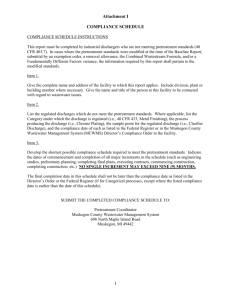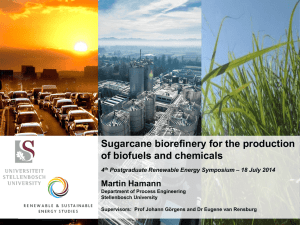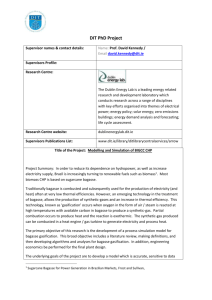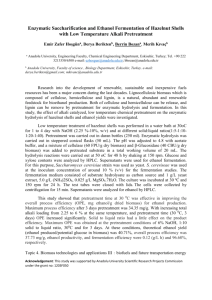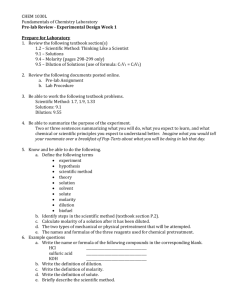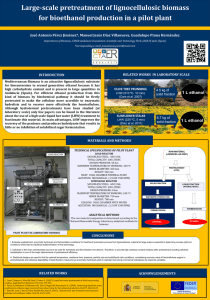Characterisation of bagasse from sugarcane cultivars for bioethanol production
advertisement
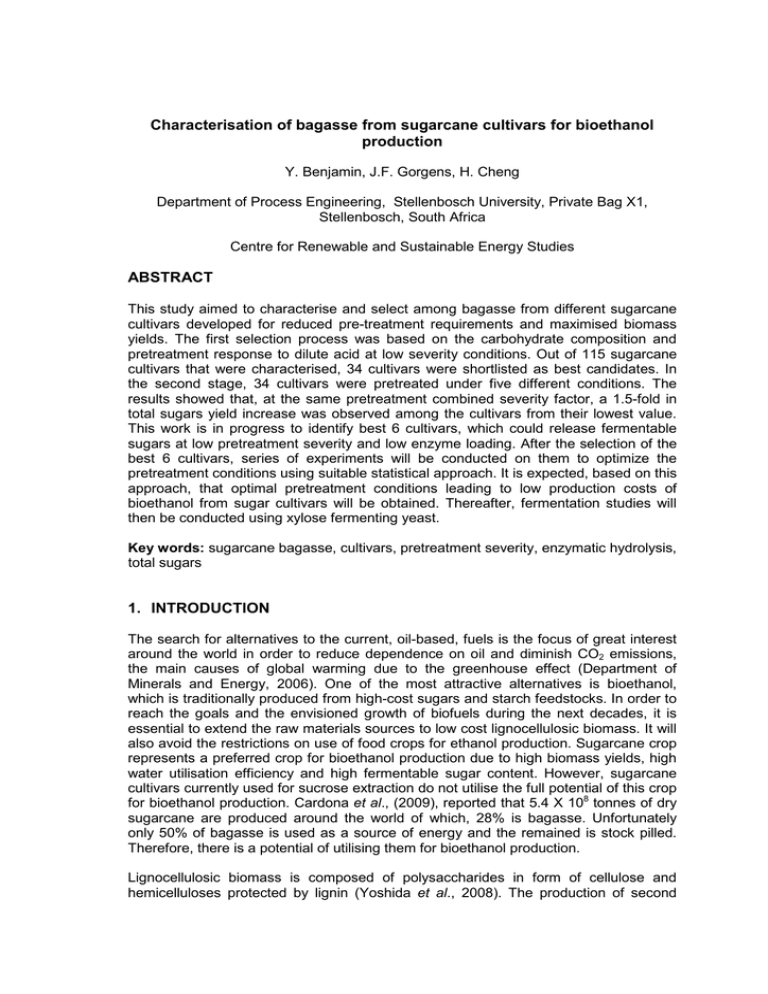
Characterisation of bagasse from sugarcane cultivars for bioethanol production Y. Benjamin, J.F. Gorgens, H. Cheng Department of Process Engineering, Stellenbosch University, Private Bag X1, Stellenbosch, South Africa Centre for Renewable and Sustainable Energy Studies ABSTRACT This study aimed to characterise and select among bagasse from different sugarcane cultivars developed for reduced pre-treatment requirements and maximised biomass yields. The first selection process was based on the carbohydrate composition and pretreatment response to dilute acid at low severity conditions. Out of 115 sugarcane cultivars that were characterised, 34 cultivars were shortlisted as best candidates. In the second stage, 34 cultivars were pretreated under five different conditions. The results showed that, at the same pretreatment combined severity factor, a 1.5-fold in total sugars yield increase was observed among the cultivars from their lowest value. This work is in progress to identify best 6 cultivars, which could release fermentable sugars at low pretreatment severity and low enzyme loading. After the selection of the best 6 cultivars, series of experiments will be conducted on them to optimize the pretreatment conditions using suitable statistical approach. It is expected, based on this approach, that optimal pretreatment conditions leading to low production costs of bioethanol from sugar cultivars will be obtained. Thereafter, fermentation studies will then be conducted using xylose fermenting yeast. Key words: sugarcane bagasse, cultivars, pretreatment severity, enzymatic hydrolysis, total sugars 1. INTRODUCTION The search for alternatives to the current, oil-based, fuels is the focus of great interest around the world in order to reduce dependence on oil and diminish CO2 emissions, the main causes of global warming due to the greenhouse effect (Department of Minerals and Energy, 2006). One of the most attractive alternatives is bioethanol, which is traditionally produced from high-cost sugars and starch feedstocks. In order to reach the goals and the envisioned growth of biofuels during the next decades, it is essential to extend the raw materials sources to low cost lignocellulosic biomass. It will also avoid the restrictions on use of food crops for ethanol production. Sugarcane crop represents a preferred crop for bioethanol production due to high biomass yields, high water utilisation efficiency and high fermentable sugar content. However, sugarcane cultivars currently used for sucrose extraction do not utilise the full potential of this crop for bioethanol production. Cardona et al., (2009), reported that 5.4 Χ 108 tonnes of dry sugarcane are produced around the world of which, 28% is bagasse. Unfortunately only 50% of bagasse is used as a source of energy and the remained is stock pilled. Therefore, there is a potential of utilising them for bioethanol production. Lignocellulosic biomass is composed of polysaccharides in form of cellulose and hemicelluloses protected by lignin (Yoshida et al., 2008). The production of second generation ethanol requires the application of a pretreatment prior to enzymatic hydrolysis to improve the accessibility of the enzymes. An efficient pretreatment alters the lignocellulosic structure by opening pore size by removing either lignin or hemicellulose or both and expose cellulose for enzyme attack (Mosier et al., 2005; Zeng et al., 2007). Also pretreatment can reduce cellulose crystallinity which, in turn favour enzymes attack (Chandra et al., 2007; Zhu et al., 2008). Similarly, good pretreatment method should be inexpensive and it should also prevent the by-products formation (Mosier et al., 2005). Several pretreatment methods have been reported in literature for lignocellulosic pretreatment (Mosier et al., 2005; Wyman, et al., 2005). Some of these methods have been used for sugarcane bagasse pretreatment: Ammonia fibre explosion (Krishnan et al., 2010), lime pretreatment (Saska and Gray, 2006; Robelo, 2009), liquid hot water (Laser et al., 2002), steam explosion (Ferreira-Leitao, et al., 2010) and dilute acid (Neureiter et al., 2002). Among these pretreatment methods dilute acid and steam explosion have been considered as economical feasible for industrial scale production because they well established, easily to control and they can handle larger quantity of biomass for shorter time. Therefore, this study has opted to use dilute acid. Using well established pretreatment, will provides opportunities to characterise bagasse from different sugarcane cultivars and manage to identify potential cultivars for bioethanol production. Normally, the pretreatment with dilute acid, hydrolyse hemicellulose and expose cellulose for enzymes attack. However, up to date, pretreatment and enzymatic hydrolysis steps are still bottle neck for industrial scale production process. The pretreatment process is energy intensive during feedstock preparation and heating, which account to 33% of the total production cost (Avira et al., 2010). Although Novozymes and Genencor, the two large enzyme manufacturers, have claimed a more than 10 fold reduction on the cost of enzymes (http://www.nrel.gov/biomass/awards.htm), still these costs are high. Therefore, there is a need of reducing these costs to make the process economically feasible. Currently, new research initiatives are being developed to find a way of reducing the production cost especially reducing the pretreatment costs and amount of enzymes required. One of these initiatives is to use classical and precision breeding of feedstocks for preferred characteristics, including higher biomass yields per hectare and chemical-physical composition that is amenable to pretreatment-hydrolysis. Any attempt to change the structure matrix of the lignocellulose biomass to make it easier for enzyme attack and reduce the pretreatment cost will be a step forward for the development of large scale, especially if this can be combined with higher biomass yields per hectare, to maximise energy production per land used. In this context, the bagasse from modified sugarcane cultivars were evaluated for bioethanol production. Firstly, the composition of the bagasse from different sugarcane cultivars were determined to evaluate differences in carbohydrates and lignin content. Secondly, these varieties were compared in terms of their response to pretreatment and enzymatic hydrolysis. 2. MATERIALS AND METHODS 2.1. Biomass materials Grinded sugarcane bagasses from 115 cultivars were received from South Africa Sugarcane Research Institute (SASRI) breeding program, which were from classical breeding or genetically modified. The bagasse were then sieved in shaker, vibrating at the amplitude of 100 for 10 minutes and those particles retained in 425 and 600 microns (i.e. 1.7 mm < particle size > 3.35 mm), were mixed together and packed in plastic bag and then were stored in a room with temperature and moisture control until were needed for the pretreatment. 2.2. Dilute sulphuric acid or hot water pretreatment Pretreatments were performed in small tubular reactors with a total volume of 14.3 ml (Yang and Wyman, 2009). Sugarcane bagasse sample of 1.5 g (dry weight) was soaked in dilute sulphuric acid or water for about 12 hours. Soaked samples were filtered to remove the excess moisture to obtain a solid content of 30% (w/v). Each reactor was loaded with the wet biomass and was compressed by a metal rod to ensure uniform heat and mass transfer. The reactors were first submerged into a sand bath set at 30°C, above the set point. The reactors were heated until the target temperature was reached, after which it was transferred into the second sand bath set at the target reaction temperature. After, the heating time completed, the reactor was quenched by submerging into cold water bath. After cooling, the wet material was vacuum-filtered into a solid and a liquid fraction. The filtrate was analysed for monomeric sugars content as described below. The pretreated solid was washed to raise the pH to at least 5 and was dried in an oven set at 40 °C for about 48 hours. In the first stage screening, all 115 sugarcane bagasse samples were pretreated at 180°C for 15 minutes with 0.5% (w/w) acid. In the s econd stage screening, the selected 34 sugarcane bagasse samples were pretreated at different five pretreatment conditions which are: (150°C, 0.96%w/w acid, 15 min utes); (160°C, 0.96 %w/w acid, 15 minutes); (190°C, 0.07%w/w acid, 15 minutes); (200° C, 0%w/w acid, 10 minutes) and (180°C, 0.5%w/w acid, 15 minutes). These conditions were selected to see the pretreatment response of cultivars at different pretreatment severities. The pretreatment conditions selected were based on preliminary experiments on one variety. 2.3. Enzymatic Hydrolysis The washed solid fraction was subjected to enzymatic hydrolysis to determine the effect of pretreatment on the enzyme accessibility of the substrate. Enzymatic hydrolysis experiments used a mixture of two commercial enzymes, Spezyme CP cellulase loading enzymes of 32.31 mg protein/g WIS (corresponding to 15 FPU/g WIS ) supplemented with β-glucosidase of 2.02 mg protein/g WIS (corresponding to 15 IU). The hydrolysis experiments were carried out in 45 ml Erlenmeyer bottles containing 200 mg (dry weight) of pretreated sugarcane bagasse and 10 ml of 0.05 M acetate buffer pH 4.8 plus the enzymes solution which made the final loading to consistency at 2 % (w/v). Then bottles were placed in the water bath shaker maintained at 50 °C and shaking at 90 strokes per minute. Samples were taken at 72 hours, treated with perchloric acid and potassium hydroxide to precipitate the enzymes (reference). Each sample was filtered through a 0.2 µm nylon membrane filter before HPLC analysis. In the second stage screening, two enzymes loading are used. The first loading is from same as that used in the first stage screening (32.31 mg protein/g WIS) and the other loading used here is 3.23 mg protein/g WIS (1.5 FPU/g WIS) and 0.20 mg/g WIS (1.5 IU/g WIS). 2.4. Lignocellulose analysis The chemical components of raw and pretreated sugarcane bagasse varieties, consisting of cellulose (glucan), hemicellulose (xylan and arabinan) and lignin were analysed by the standard method developed by NREL analysis procedure LAP 002, 003, 017, 019 (http://www.nrel.gov/biomass/analytical_procedures.html). In brief, 3 g of milled and sieved samples was extracted with 95% ethanol for six hours in a Soxhlet apparatus. Extractive-free biomass was hydrolysed with 72% sulphuric acid (% w/w) (0.3 g material and 3 ml sulphuric acid) in a heating water bath set at 30°C for 60 minutes. The sample was then diluted with 84 ml of de-ionised water to make the final concentration 4% w/w H2SO4 and the mixture was autoclaved at 121°C for 60 minu tes. The resulted mixture was filtered in a porous crucible. The filtrate (liquid fraction) was taken for monomeric sugars analysis. The solid fraction was dried calcinated at 575°C. The left material was cooled in desiccators and weighed to determine the amount of insoluble lignin. Soluble lignin was in the liquid fraction was measured by UVspectrophotometer at a wavelength of 220 nm. 2.5. HPLC analysis The samples diluted to suit HPLC range and were centrifuged at 14000 rpm for five minutes, and then were filtered using 0.22 µl nylon filters. Samples from raw material, pretreated material and enzymatic hydrolysis were analyzed for sugar content (glucose, xylose and arabinose) by high performance anionic exchange chromatography on a Dionex Ultimate® 3000 system equipped with a CarboPac PA1 column (4x250 mm) operated at 25 °C with a mobile p hase of 30 mM sodium hydroxide and a flow rate of 1ml/min. 2.6. Pretreatment severity factor analysis The pretreatment combined severity factor (CSF) was used to measure the magnitude of the severity of the pretreatment by combining temperature, time and acid concentration. The combined severity factor was calculated from equation 1 (Chum et al., 1990; Guo et al., 2008). log log (1) Where, “pH” is the pH of the pretreatment liquor. Ro is the severity factor defined by equation 2 (Kabel et al., 2007) exp . (2) Where “t” represents the time for reaction in minutes “TH” is the reaction temperature in °C, “ TR” is the reference temperature which is assumed to be 100 °C. 3. RESULTS 3.1. First Stage Screening The first stage screening aimed to identify those cultivars with improved properties for bioethanol production such as sugar and fibre yield per hectare, high sugar content of the fibre and efficient response to pretreatment and enzymatic hydrolysis. 3.1.1. Composition of Sugarcane Bagasse Cultivars Figure 1 represents the composition analysis of sugarcane bagasse from 115 cultivars used in this study. Glucan, xylan, arabinan and lignin content ranged from 33.7-42.9%, 20.3-30.6%, 1.3-4.0% and 13.7-26.1%, respectively. These results are comparable to normal sugarcane bagasse obtained elsewhere (Leser et al., 2002;Sigueira et al., 2010; Ferreira-Leitao et al., 2010). The variation of glucan, xylan, arabinan and lignin contents among the cultivars could be due to biological differences. However, cultivars from genetic modified had lower lignin than those one from classical breeding which, is a preferred characteristics for lignocellulosic pretreatment. Figure 1. Average composition of sugarcane bagasse from 115 cultivars used in this study 3.1.2. Total Sugars Yield Total sugars yield refers to the sugars recovered from pretreatment (liquid fraction) plus sugars released during enzymatic hydrolysis (solid residue after pretreatment). Figure 2 represents the variation of xylose, glucose and total sugar during pretreatment and enzymatic hydrolysis of sugarcane bagasse from 115 cultivars. Xylose, glucose and total sugars ranged from 7.7-20.4 g/100g dry raw bagasse, 7.4-32.8 g/100g dry raw bagasse, and 27.3-55.2 g/100g dry raw bagasse, respectively. The standard deviation was less than 10% showing good reproducibility (data are not shown in Figure 1). It can be observed that each cultivar responded differently in terms of the sugars release. This could be attributed to the difference on lignin content. Generally, those samples with low lignin content appeared to have higher sugar release than those with higher lignin content. For example the total sugars release for sample number 101 (lignin content, 13.3%) was 49.8 g/100 g dry raw bagasse compared to 27.3 g/100 g dry raw bagasse of sample number 11 (lignin content, 20.4). In addition, bagasse from those cultivars developed by genetic modification appeared to have higher sugars release than those one from conversional breeding. Figure 2. Total glucose, xylose and overall sugars (g/ 100 g raw material) obtained as monomers after pretreatment and enzymatic hydrolysis of bagasse from 115 sugarcane varieties. 3.1.3. Selection criteria and selected cultivars The selection of preferred 34 samples was based on different criteria considering agronomic properties of the cultivars (tons biomass/ ha, tons sugar/ha, tons fibre/ ha), carbohydrate content of the fibre and its response to the pretreatment and enzymatic hydrolysis. The properties and results obtained for the selected samples in this first screening are summarized in Table 1. The results shows that, sugarcane yield ton per ha, fibre yield ton per ton cane, sugars (juice) yield ton per ton cane, fibres carbohydrates component/100g dry raw bagasse, and total sugars yield/100g dry raw bagasse were in range of 72.3-126.4, 0.2-0.1, 0.2-0.1, 54.0-75, 29.9-49.8, respectively. The cultivars number 15 with lowest pretreatment response (29.9 g/100g dry raw bagasse) was selected due to high sugarcane yield per hectare (125.4 ton/ha). Table 1. Selected sugarcane cultivars for second stage screening Sample Type Sugars Fibre, Cane, (juice), ton/ ton/tonne ton/ha ton cane cane Bagasse composition g/100g raw bagasse Total sugar yield, g/100g Lignin Carbohydrates 1 CB 0.15 0.13 107.66 17.65 66.61 44.63 4 CB 0.15 0.15 91.02 16.4 64.84 45.87 5 CB 0.17 0.12 98.48 14.01 68.97 46.09 6 CB 0.15 0.12 123.91 17.13 61.53 34.95 8 CB 0.16 0.15 109.00 15.82 66.37 34.22 12 CB 0.16 0.13 122.95 18.91 62.63 34.62 13 CB 0.17 0.13 105.59 14.93 64.22 31.93 15 CB 0.16 0.12 125.42 18.85 69.52 29.92 16 CB 0.17 0.13 122.37 16.88 65.56 48.43 20 CB 0.16 0.16 20.41 63.01 47.43 28 CB 0.16 0.19 18.3 65.88 48.4 30 CB 0.16 0.17 19.84 69.72 41.41 34 CB 0.18 0.14 99.42 19.71 64.34 38.51 54 CB 0.16 0.13 118.50 18.95 64 42.19 55 CB 0.15 0.14 124.06 19.52 66.66 47.69 57 CB 0.15 0.15 121.26 17.43 71.45 43.17 58 CB 0.15 0.15 72.33 18.24 60.46 33.85 63 CB 0.15 0.14 109.5 17.19 64.22 43.57 70 CB 0.15 0.13 126.47 18.46 64.83 39.65 71 CB 0.16 0.14 112.13 16.8 65.33 36.74 74 CB 0.15 0.16 98.13 21.48 74.36 36.78 87 CB 0.18 0.13 18.71 59.67 45.94 88 CB 0.17 0.12 20.78 74.99 44.56 89 CB 0.15 0.19 17.37 54.82 46.55 94 CB 0.15 0.13 122.33 18.57 66.45 39.94 97 CB 0.15 0.16 109.33 18.89 63.26 46.54 101 GM 0.15 0.15 13.31 68.69 49.84 102 GM 0.15 0.15 15.71 70.33 49.05 103 GM 0.15 0.15 15.88 64.4 47.67 104 GM 0.12 0.09 16.74 60.28 46.84 Table 1. (continued) 98.56 105 GM 0.12 0.11 15.22 53.99 39.88 106 GM 0.15 0.15 15.59 68.3 49.08 109 GM 0.15 0.15 16.31 67.73 45.09 114 GM 0.08 0.15 15.31 66.55 45.16 3.2. Second stage screening In order to limit the number of samples for further optimization, a second stage of screening was performed on the 34 cultivars selected. With this aim, the difference on the sugar yield obtained after a low severity pretreatment and enzymatic hydrolysis at low enzyme dosage was evaluated. 3.2.1. WIS recovered Figure 3 represents the correlation between combined severity factor (CSF) and the average percentage of pretreated insoluble solid (WIS) recovered of 34 sugarcane bagasse cultivars. As expected, the recovery of solids after pretreatment decreased while increasing the combined severity factor. For the conditions tested, the WIS recovered varied from 67.3% (CSF= 0.67) to 50.8% (CSF= 1.95). The decrease of WIS recovered could mainly due to solubilization of hemicellulose. Figure 3: WIS recovered as a function of combined severity factor after pretreatment of sugarcane baggasse from 34 cultivars at different conditions 3.2.2. Xylose yield from pretreatment Figure 4 represent monomeric xylose yield (g/100 g dry raw bagasse) as a function of combined severity factor during pretreatment of sugarcane bagasse from 34 cultivars. The amount of monomeric sugars is an important measure of the effectiveness of the dilute acid pretreatment process. The monomeric xylose yield during pretreatment ranged from 2.9 to 19.8 g/100g dry raw bagasse observed at CSF of 0.56 and 1.01, respectively. There was substantial difference in the xylose yield among cultivars obtained at the same combined severity factor. The results show that the xylose yield in the pretreated liquor increased with CSF to a certain combined severity factor and it appeared that at CSF=1.9, xylose release started decreasing which, could be due to by-product formation. As expected, the lowest xylose yields were obtained when low or no acid was used during pretreatment, whereby larger portion of hemicellulose was left in form of oligomers or unconverted. Figure 4. Average monomeric xylose in the pretreated liquor as a function of combined severity factor after pretreatment of sugarcane baggasse from 34 cultivars. 3.2.3. Glucose from Enzymatic hydrolysis Figure 5 represents the glucose yield (g/ 100 g raw material) as function of the combined severity factor of pretreated solid of the selected 34 sugarcane cultivars. The glucose yield varied from 12.8 to 37.7 g/100g dry raw bagasse observed at CSF of 1.01 and 0.56, respectively. The glucose yield was affected by the increase of combined severity factor. However, some cultivars pretreated at CSF=1.01 resulted in lower glucose yield. In addition, cultivars from genetic modified were observed to have higher glucose released than those one from classical breeding. This observation could be attributed to lignin content which normally has a negative effect to enzymatic hydrolysis. Lignin content of genetic modified cultivars ranged from 13.3%-16.7% compared to 14.0%-21.5% of those obtained by classical breeding. Figure 5. Average glucose yield during enzymatic hydrolysis at 15 FPU/g WIS from bagasse of the seleced 34 sugarcane cultivars as a function of pretreatment combined severity factor. 3.2.4. Total sugars yield The total sugars yield (pretreatment and enzymatic hydrolysis) (g/100 g dry raw material) as function of the combined severity factor (CSF) is represented in Figure 6. The maximum and minimum sugars yields was 33 and 59 g/100g dry raw bagasse, attained at CSF of 0.56 and 1.01, respectively. As it can be observed, the total sugars yield was increased with increasing combined severity factor. Also, there is substantial difference among the cultivars with genetic modified cultivars being on higher side as being explained previously. However, total sugars yield explained here only included the monomeric sugars from pretreatment and enzymatic hydrolysis.The total sugars will then be used with other adjacent selection criteria to identify the possible six candidates for the further work. Figure 6. Average total sugars yield during pretreatment and enzymatic hydrolysis WIS of 34 sugarcane bagasse cultivals as a function of pretreatment combined severity factor. 3.2.5. Analysis of variance of total sugars One-Way-Analysis of variance (ANOVA) was performed to determine whether there was significance difference in the average of total sugars yield among the cultivars at same combined severity factor. Also ANOVA was performed to verify whether there was significance difference in the average of total sugar yield at different severity factor. The analysis was performed by using excel statistical add-in-package. The ANOVA results indicate that there was significant difference among the cultivars and between the cultivars and combined severity factor at 95% confidence level interval. Summary of ANOVA table for cultivars and combined severity factor Group-CSF 0.56 0.87 1.01 1.65 Count 34 34 34 34 Sum 1547.56 1376.16 1304.25 1619.76 Average 45.52 40.48 38.36 47.64 Variance 23.40 19.80 9.56 19.70 ANOVA Source of Variation Between Groups Within Groups Total SS 1895.94 2391.76 4287.70 df 3 132 135 MS 631.98 18.12 F 34.878 P-value 1.1484E-16 4. CONCLUSIONS This work proves the impact of differences chemical composition among the different cultivars on the pretreatment response. The genetically modified cultivars performed better than those cultivars from classical breeding. 5. REFERENCES Avira, P., Tomas-Pejeo, E., Ballesteros, M., Negro, M.J. 2010. Pretreatment technologies for an efficient bioethanol production process based on enzymatic hydrolysis: A review. Bioresource Technology. 101 (13): 4851-4861 Cardona, C.A., Quintero, J.A., Paz, I.C. 2009. Production of bioethanol from sugarcane bagasse: Status and perspectives. Bioresouces Technology. doi:10.1016/j.biortech.2009,10.097. Chandra, R.P. Bura, R., Mabeel, W.E. Berlin, A., Pan, X., Saddler, J.N. 2007. Substrate Pretreatment: The key to effective enzymatic hydrolysis of lignocellulosics? Adv Biochem Engin/Biotechnol. 108: 67-93. Chum, H., Johnson, D.K., Black, S.K., (1990). Organosolv pretreatment for enzymatic hydrolysis of poplars. 2. Catalyst effects and combined severity parameter. Ind Eng Chem Res. 29: 156-162. Department of Minerals and Energy. 2006. Draft Biofuels Industrial Strategy of the Republic of South Africa. Official report. Features of promising technologies for pretreatment. Bioresource Technology. 96: 673686. Ferreira-Leitao, V., Perrone, C.P., Rodrigues, J., Franke, A.P.M., Macrelli, S., Zacchi, G. 2010. An approach to the utilization of CO2 as impregnating agent in steam pretreatment of sugar cane bagasse and leaves for ethanol production. Biotechnology for biofuels, http://www.boptechnologyforbiofuels.com/content/3/1/7 Ferreira-Leitao, V., Perrone, C.P., Rodrigues, J., Franke, A.P.M., Macrelli, S., Zacchi, G. 2010. An approach to the utilization of CO2 as impregnating agent in steam pretreatment of sugar cane bagasse and leaves for ethanol production. Biotechnology for biofuels. http://www.boptechnologyforbiofuels.com/content/3/1/7 Guo, G.-l., Chen, W.-H., Chen, W.-H., Hwang, W.-S. 2008. Characterization of dilute acid pretreatment of silvergrass for ethanol production. Bioresource Technology. 99: 6046-6053. Kabel, M.A., Bos, G., Zeevalking, J., Voragen, G.J., Schols, H.A. 2007. Effect of pretreatment severity on xylan solubility and enzymatic breakdown of the remaining cellulose from wheat straw. Bioresource Technology. 98: 2034-2042 Krishnan, C., Sousa, L.C., Jin, M., Dale, B.C. and Balan, V. 2010. Alkali-based AFEX pretreatment for the conversion of sugarcane bagasse and can leaf residues to ethanol. Biotechnology and Bioengineering. DOI: 10.1002/bit.22824. Laser, M., Schulman, D., Allen, s.G., Lichwa, J., Antal, M.J., Lynd, L.R. 2002. A comparison of liquid hot water and steam pretreatments of sugarcane bagasse for bioconversion to ethanol. Bioresource Technology. 81: 33-44 Laser, M., Schulman, D., Allen, S.G., Lichwa, J., Antal, M.J., Lynd, L.R., 2002. A comparison of liquid hot water and steam pretreatments of sugarcane bagasse for bioconversion to ethanol. Bioresource Technology. 81: 33-44. Mosier, N., Wyman, C., Dale, B., Elander, R., Lee, Y.Y., Holtzapple, M., Ladisch, M. 2005. Features of promising technologies for pretreatment of lignocellulosic biomass, Neureiter, M., Dinner, H., Thomasser, C., Saidi, B., and Braun, R. 2002. Dilute Hydrolysis of Sugarcane Bagasse at varying conditions. Applied Biochemistry and Biotechnology. 98-100: 49-58 NREL-National Renewable Energy Labolatory. 2010. Laboratory Analytical Procedure http://www.nrel.gov/biomass/analytical_procedures.html. Robelo, S.C., Maciel-Filho, R., Costa, A.C. 2009. Lime pretreatment of sugarcane bagasse for bioethanol production. App Biotechnol. 153 (1-3): 139-150. Saska, M. and Gray, M. 2006. Pre-treatment of sugarcane leaves and bagasse pith with lime-impregnation and steam explosion for enzymatic conversion to fermentable sugars. 28th Symposium of Biotechnology for Fuels and Chemicals, Nashville, TN. Siqueira, G., Mandes, F., Carvalho, W., Ferraz, A., Milagrres, A., 2010. Enzymatic hydrolysis of chemithermomecally pretreated sugarcane bagasse and two experimental samples with reduced initial lignin content. Journal of Biotechnology in Progress. Under review. Wyman, C.E., Dale, B.E., Elander, R.T., Holtzapple, M., Ladisch, M.R., Lee, Y.Y. 2005. Coordinated development of leading biomass pretreatment technologies. Bioresource Technology. 96: 1959-1966. Yang, B. Wyman, C.E. 2009. Dilute and Autohydrolysis Pretreatment. Mielenz, J.R. (ed.), Biofuels: Methods and protocols, Methods in Molecular Biology. 581: 103114. Yoshida, M., Liu, Y., Uchida, S., Kawarada, K., Ukagami, Y. 2008. Effects of cellulose crystallinity, hemicellulose, and lignin on the enzymatic hydrolysis of miscanthus sinensia to monosaccharides. Biosci. Biotechnol. Biochem. 72, (3): 805-810. Zeng, M., Mosier, N.S., Huang, C-P., Sherman, D.m., Ladisch, M.R. 2007. Microscopic examination of plant cell structure in corn stover due to hot water pretreatment and enzymatic hydrolysis. Biotechnology and bioengineering. 97 (2): 265-278. Zhu, L., O’Dwyer J.P., Chang, V.S., Granda, C.B. and Holtzapple, M.T. 2008. Structural Features Affecting Biomass Enzymatic Digestibility. Bioresource Technology. 99: 3817–3828 http://www.nrel.gov/biomass/awards.htm


